The pawnThe pawn is the piece with the smallest value on the board. But pay attention! Don't fall in the trap that many beginners tend to fall into, of thinking the pawn is not important. It is very important as you will see. At the beginning of the game each side has eight pawns positioned as shown in the following diagram.  The pawn can only move forward one square as long as the square in front of it is not occupied with another piece. From the initial position the pawn can move two squares. Look at the following image to see how the pawns can be moved.  In the following game none of the pawns, black or white, can be moved because they are blocked by other pieces. 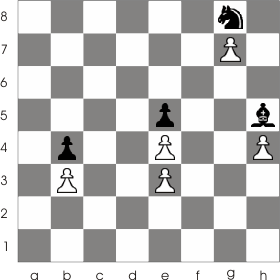 A pawn can capture a piece that's one column on its left or right side and one row in front of it. That means that it can capture by going one square forward on the diagonal as shown in the image below. There are cases when a pawn can capture a piece but may choose not to do that. For example, in the image below, the white pawn from h2 can simply move forward at h3 or h4 without capturing the black rook. That would be a perfectly legal move. You can learn more about capturing pieces at learn to capture.  En passant captureThere is another kind of capture a pawn can do. If a pawn has under control a square over which an enemy pawn jumps (when making its initial move) that pawn can capture the enemy pawn by moving on the square in front of the initial position of the enemy pawn. This is called en passant and is a french term which means "in passing". For a better understanding of this move take a look at this example. Pawn promotionThere is another thing you should know about the pawn. One of the things that makes it so important. If a pawn reaches the last line (1 for black pawns or 8 for white pawns) it can and must be replaced immediately with a piece of its own color except the king. This is called a promotion. The pawn can be replaced with queen, rook, knight or bishop, even if those pieces are already on the board. So you could possibly end up with 2 queens 3 rooks and so on. Usually the pawn which reaches the final line is transformed in a queen (this being the strongest piece on the chess board), but that is not always the case. Sometimes it pays off promoting another piece depending on the position. The importance of the pawnAt the beginning of the article I mentioned that the pawn is very important. You can understand now why is that, by knowing that a pawn can be promoted. But that is not the only reason that makes this piece so important. The fact that this piece has the smallest value makes it so important. Sounds confusing? Well.. it's not, and I'll show you why. The fact that it has the smallest value means that the opponent can't change a piece having a bigger value with one of your pawns because that would lead to him losing the game. So the squares that are under the control of your pawns are the strongest for you. 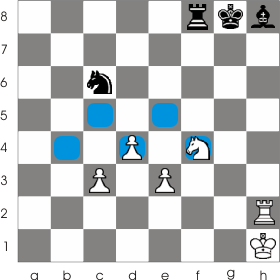 The blue squares are strong. They are under the control of the two pawns. You can see that Black can't move his pieces on the blue square nor he can capture the knight at f4 with the rook. If he does either of those things he looses a piece over a pawn which could lead to his defeat.
The rookThe rook is a valuable piece. Its value on the board is bigger than that of the pawn, the bishop and the knight but smaller than that of the queen. At the beginning of the game the rooks are placed in the corners of the board just like in the following image.  The rook can move along the ranks and files of the chess board as long as it doesn't bump over a piece.  In the example bellow the rook can only move on the highlighted squares, because it is blocked by a few pieces (but notice that White is able to move the rook to e2 or b5 by capturing the black pieces on those squares ).  The rook can capture any enemy piece that is on a square that the rook can move on. In the example above the white rook can capture the bishop at e2, but can't go pass it on the same move. The rook can also do a special move called castling which involves moving the king and the rook at the same time, but we'll talk about that later at castling .
The bishopThe bishop has the same value as the knight. Its value is greater then that of the pawn but smaller then those of the rook and the queen. At the beginning of the game each side has two bishops, one placed on a dark square and one on the light square just like in the following game.  The bishops move on the diagonals. They will always move on diagonals of the same color as the color of the square that they occupy at the beginning of the game( This is common sense : because they can move only on the diagonal, they will never leave the initial color). Watch the example below to see how the bishop can move. Just like the rook the bishop can't jump over pieces. 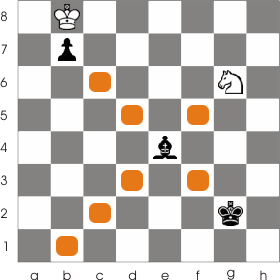 The bishop captures pieces the same way it moves. More specific it moves along the diagonal until it reaches the enemy piece then takes its place and gets it out of the game. In the game above the black bishop can capture the white knight at g6 by taking its place.
The knightThe knight has the same value as a bishop. That means that it has a value grater than that of the pawn but smaller then those of the rook and queen. You can see the initial positions of the knights in the following image. The knight is the only piece that can jump over other pieces may this be enemy pieces or pieces in its own team. It has a relatively short range of action in comparison with the bishop but it compensates that with the fact that it can jump over other pieces. It moves in any direction over two squares in a line and then over one square in a diagonal. But to put it more simply it moves in an L trajectory, the 'L' being composed of 4 squares. Look at the board below to get the idea.  It can only capture the piece that is on its destination square. It can't capture the pieces over which it jumps. When it captures a piece it takes its place.  You can see in the example above that the knight at d4 can capture the black pawn at e2. It does this by taking its place. Notes that it has no problem with the bishop at e3; it simply jumps over it.
The queenThe queen is the strongest piece on the board; it has the greatest value of all the pieces. You can see the initial positions of the two queens in the image below. Notes that the queen is always placed in its original position on a square of its own color. That means that the white queen will be placed on a white square and the black queen on a black square.  The queen is considered the most powerful piece on the table due to its great mobility and also because it can control and attack pieces and squares found on its range of action (which is quite large as you can see in the image below).  It can move along ranks, files and diagonals any number of squares without being able to jump over pieces. If it finds an enemy piece in its path it can capture that piece by taking its place.  You can see in the game above that the queen range of action is diminished by some enemy pieces and by its own pieces. The queen can capture the knight at b5 or the pawn at f7 by taking their place. It could also capture the rook from a8 but that would be unadvised because a8 is under the protection of the e8 rook.
The kingThe king is the most important piece on the board. The entire game revolves around the king; more exactly, the purpose of the game is to checkmate the opponent's king. The kings initial positions are as in the following picture.  The king can move one square, in any direction, as long as that square is not occupied by one of its own pieces or it's not in the range of action of an enemy piece. The king can capture a piece that is on a square that it can move on. Because the way the king moves - one square in any direction, the two kings must always be separated by a square - so they don't enter one in each others range of action. You can see how the king can move in the picture below (the orange squares).  The position in the following image is illegal. The two kings must be separated by at least one square. 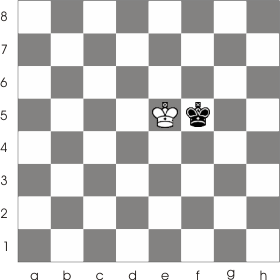 In the following example the white king can only move on certain squares. It is unable to move anywhere on the 6th rank because that rank is under the control of the black rook from e6. It can't move on the a7 and c7 either, because of the black knight at b5. So, the only squares on which it can move are a8, b8 and c8.  Watch the following example to see how the king can capture an enemy piece. The white king is unable to capture the black knight at g4 because that square is under the control of the black king. It can't capture the black pawn at e3 either, because the e3 square is under the control of the black knight. It can, however, capture the bishop at g3 by taking its place.  There is also a special move the king can do only one time in a game in relation with the rook and in certain conditions :castling. But I'll talk about that in one of the following tutorials. |
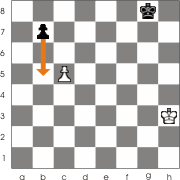 Black makes his move
Black makes his move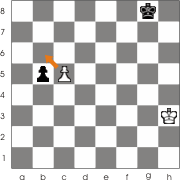 White captures the black pawn
White captures the black pawn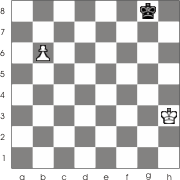 The position after the 'en passant'
The position after the 'en passant'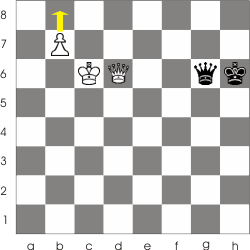 White has his turn to move
White has his turn to move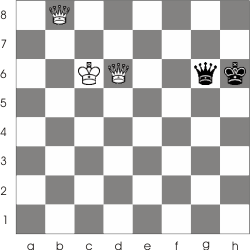 The pawn is promoted into a queen
The pawn is promoted into a queen